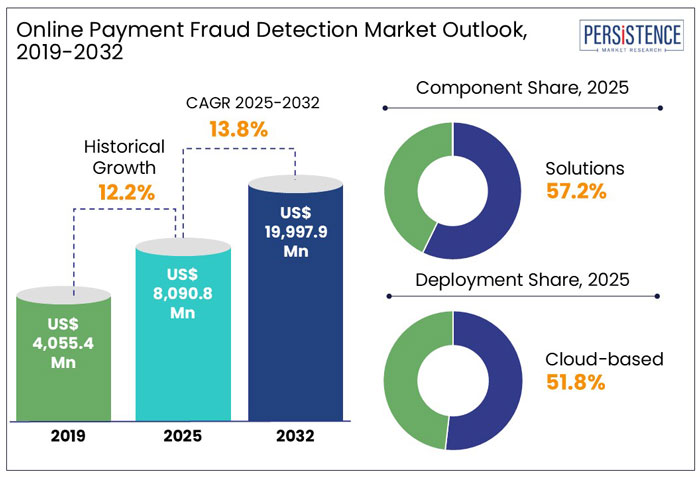Industry: IT and Telecommunication
Published Date: April-2025
Format: PPT*, PDF, EXCEL
Delivery Timelines: Contact Sales
Number of Pages: 321
Report ID: PMRREP33078
The global online payment fraud detection market size is projected to rise from US$ 8,090.8 Mn in 2025 to US$ 19,997.9 Mn by 2032. It is anticipated to exhibit a CAGR of 13.8% during the forecast period from 2025 to 2032.
According to Persistence Market Research, the proliferation of mobile devices has given rise to the increasing use of digital payment methods. This has created new avenues for fraudsters to exploit vulnerabilities. Online fraud detection solution providers are likely to focus on upgrading their existing lines to adapt to the changing landscape of digital and mobile transactions.

Key Industry Highlights
|
Global Market Attributes |
Key Insights |
|
Online Payment Fraud Detection Market Size (2025E) |
US$ 8,090.8 Mn |
|
Market Value Forecast (2032F) |
US$ 19,997.9 Mn |
|
Projected Growth (CAGR 2025 to 2032) |
13.8% |
|
Historical Market Growth (CAGR 2019 to 2024) |
12.2% |
The emergence of synthetic identity fraud, which is costing organizations billions worldwide, is anticipated to boost online payment fraud detection solution demand. According to the Global Compliance Institute, the average loss to each synthetic fraud case in the U.S. is US$ 15,000. This complex scheme accounts for more than 80% of new account fraud.
Perpetrators often create whole new personas by piecing together fake and real data. As these fake identities can go unnoticed for years, they can develop a false credit profile and use it to their advantage. Lenders mainly face staggering exposure, backed by synthetic identity fraud across unsecured loans, auto loans, and credit cards.
Easy access to artificial intelligence (AI)-backed tools is projected to contribute to the rise of fraud losses. With platforms that can rapidly create fake customer data to match with current Social Security Numbers (SSNs), AI is set to enable synthetic identity theft.
While it is different from AI-generated fraud, which includes deepfakes or biometric impersonation, synthetic identity theft is anticipated to develop with AI support. Organizations will likely continue to invest in solutions like behavioral biometrics to eliminate synthetic fraud.
Online payment fraud detection and prevention may face a key challenge of false positives. Overly sensitive fraud detection systems have the ability to flag valid transactions as suspicious, that causes delays, customer inconvenience, and possible harm to customer relationships. Too many false positives can also create a burden on resources and reduce the effectiveness of fraud detection initiatives.
To balance efficiency and accuracy in detecting fraudulent activities, reducing false positives necessitates optimizing detection algorithms, integrating contextual data into decision-making processes, and continuously improving detection techniques. Forbes recently found that in the U.S., one-third of customers who experience a false decline state mentioned they will never rely on the same merchant again. Hence, when an authentic customer is blocked, an authentic sale is blocked.
The use of predictive analytics in online fraud detection is anticipated to create a new opportunity in the global market through 2032. Predictive analytics is capable of empowering businesses to preempt and estimate fraudulent activities even before they occur.
Businesses can examine significant information to find patterns, trends, and irregularities suggestive of possible fraud by adopting predictive analytics. By taking a proactive stance, they can put preventative measures in place. These often include improved authentication procedures, transaction monitoring, and detection of anomalies to reduce fraudulent activities before these cause monetary losses.
Various companies are already offering new solutions equipped with predictive analytics capabilities to eliminate fraudulent activities online. Neural Technologies, for example, provides fraud management solutions equipped with predictive analytics. It offers in-depth information about subscriber behaviors, payment patterns, and network usage to efficiently detect fraudulent transactions.
The field of online payment fraud detection is evolving with the emergence of deep learning. It offers a highly intelligent and adaptive approach to detecting fraudulent activities. Deep learning models constantly learn from new information, enhancing their ability to check complicated fraud patterns in real time.
The ability to analyze a vast data set like contextual data, customer behavior, and transaction histories enables deep learning models to differentiate between fraudulent and genuine activities. Transformer-based architecture and Recurrent Neural Networks (RNNs) help process transaction sequences to detect sudden changes in a customer's regular pattern or unusual spending habits.
Based on component, the solutions segment will likely hold a share of around 57.2% in 2025. Businesses are set to mainly prefer online payment fraud detection solutions providing self-service dashboards.
Instead of depending on external fraud detection services, these solutions enable independent control of fraud risks. E-commerce companies can use AI-based fraud detection solutions to automatically prevent fraudulent orders while clearing genuine transactions, eliminating the need for external fraud analysis services.
In terms of deployment, the cloud-based segment is anticipated to generate an online payment fraud detection market share of nearly 51.8% in 2025. This is attributed to the ability of cloud-based fraud detection systems to gain access to real-time fraud data from global transactions. It helps them to assess new fraud patterns more quickly.
On-premises solutions, on the other hand, heavily rely on static rule-based systems. These often require manual updates, which can pose high risks of new fraud tactics for businesses. These also require high capital investments in IT staff, software, as well as hardware licensing for maintenance and upgradation purposes, thereby limiting adoption.

North America is predicted to hold a share of about 21.6% in 2025, spurred by evolving fraud tactics like card-not-present (CNP) and synthetic identity fraud as well as high volume of digital transactions. The region is anticipated to be driven by the U.S. online payment fraud detection market as fraud detection solutions are considered significant for e-commerce firms and financial institutions.
The Federal Trade Commission (FTC), for instance, mentioned that losses from online payment fraud and impersonation scams in the U.S. surpassed US$ 10 Bn in 2023. Regulatory frameworks like the Consumer Financial Protection Bureau (CFPB) norms and the Federal Reserve’s faster payment initiatives are set to propel businesses to embrace fraud detection tools for real-time assessment.
Asia Pacific will likely showcase considerable growth in the market through 2032. In the region, China is estimated to be a frontrunner due to the presence of several digital payment apps like Alipay and WeChat Pay.
Increasing use of mobile wallets and QR-code payments has led to a surge in online fraud in the country, mainly account takeovers and phishing scams. Local financial institutions are hence adopting fraud detection models based on AI to assess transaction patterns in real time.
The People’s Bank of China (PBOC), for instance, recently implemented anti-money laundering (AML) norms. These enabled businesses to use behavioral analytics and biometric authentication to effectively prevent fraudulent activities.
In India, online payment fraud has become a matter of concern with Unified Payments Interface (UPI) handling billions of transactions every month. Mule accounts, fake merchant scams, and SIM swap fraud are a few key fraudulent activities occurring in the country. Local fintech companies like Paytm and Razorpay have integrated blockchain, machine learning, and AI-based fraud detection and prevention to improve security.
In the Middle East and Africa, the UAE is rapidly shifting toward a cashless economy due to the growth of digital wallets, buy now, pay later services, and e-commerce boom. Fraudsters are exploiting this surge in online transactions, making innovative fraud detection solutions a requirement. The Central Bank of the UAE (CBUAE), for instance, has made it mandatory for payment providers and banks to adopt real-time fraud monitoring.
Nigeria has been witnessing a significant rise in online payment fraud, including social engineering scams. The Central Bank of Nigeria (CBN) has implemented robust customer authentication (SCA) norms. Under these norms, financial service providers are required to use multi-factor authentication.
The global online transaction fraud detection market is highly competitive with various large-scale companies aiming to launch new solutions. They are striving to come up with innovative solutions that would help detect fraud even before they occur in real time. A few companies are joining hands with significant players in the BFSI industry to co-develop new solutions.
|
Report Attributes |
Details |
|
Historical Data/Actuals |
2019 - 2024 |
|
Forecast Period |
2025 - 2032 |
|
Market Analysis Units |
Value: US$ Bn/Mn, Volume: As Applicable |
|
Geographical Coverage |
|
|
Segmental Coverage |
|
|
Competitive Analysis |
|
|
Report Highlights |
|
|
Customization and Pricing |
Available upon request |
By Component
By Deployment
By Vertical
By Region
To know more about delivery timeline for this report Contact Sales

The market is projected to be valued at US$ 8,090.8 Mn in 2025.
The market is estimated to rise at a CAGR of 13.8% through 2032.
ACI Worldwide, Experian, SecuroNix, Accertify, and Feedzai are a few leading providers.
Cloud-based deployment segment is set to lead the market.
Solutions are the most preferred component in the market.